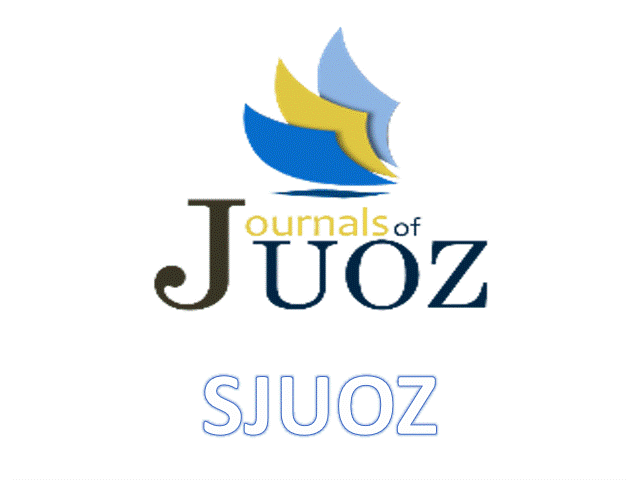Approximate Solutions for A Model of Reaction-Diffusion System with Slow Reaction and Fast Diffusion
Keywords:
Reaction-Diffusion system, Perturbation method, Finite difference, Traveling wave solutionsAbstract
In this paper, perturbation and finite difference methods are used to solve a reaction diffusion system. This system is modeled for describing the interaction between species in ecology. The interaction is interpreted as traveling wave solutions for both species under three types of initial conditions which describe some ecological cases. Types of traveling wave solutions are found and studied using numerical and approximate methods when there exists a small parameter appear in one of the equation. The solutions of the two methods are compared and show a good agreement.
Downloads
Download data is not yet available.
References
A. Dean, A simple model of Mutualism. The American Naturalist, vol. 121, (1983), 409-417.
A. Priyanga, Spatial dynamics of Mutualistic interactions. Journal of Animal Ecology, vol. 73, (2004), 128-142.
F. Brauer. On the populations of Competing Species. Mathematical Biosciences, vol. 19, (1974), 299-306.
J. Billingham. Dynamics of a strongly nonlocal reaction-diffusion population model. Nonlinearity, vol. 17, (2004), 313-346.
J. Billingham. Phase plane analysis of one-dimensional reaction diffusion waves with degenerate reaction terms}. Dynamics and Stability of Systems, vol. 15 (2001), 23-33.
J.D. Murray. Mathematical Biology I: An introduction. Springer-Verlag, New York, 2002.
J.F. AL-Omari, S. A. Gourley. Stability And traveling Fronts In Lotka-Voltera Competition Models With Stage Structure}. J. Appl. Math, vol. 63, (2003), 2063-2086.
K. Gopalsamy. Exchange of Equilibria in Two Species Lotka-Voltera Competition Models. J. Austral. Math. Soc., vol. 24, (1982), 160-170.
K. Hardler, F. Rothe. Traveling fronts in nonlinear diffusion equations. Math. Biol., vol. 2, (1975), 251-263.
N. Britton. Reaction-Diffusion Equations And Their Applications To Biology. Academic Press INC. (London) LTD, 1986.
N. F. Britton. Spatial structures and Periodic traveling waves in an integro-differential reaction-diffusion population model}. Siam Journal on Applied Mathematics, vol.50, No.6 (1990), 1663-1688.
S. A. Gourley. Two-Species Competition With High Dispersal: The Winning Strategy. Mathematical Biosciences And Engineering, vol.2, No.2 (2005), 345-362.
W. Graves, B. Peckham and J. Pastor, A bifurcation analysis of a differential equations model for Mutualism. Bulletin of Mathematical Biology, DOI 10.1007/s11538-006-9070-3, (2006).
V. Volpert, S.Petrovskii. Reaction-diffusion waves in biology. Physics of Life Reviews, vol.6, (2009), 267-310.
Y. Hosono. traveling Waves For A Diffusive Lotka-VolteraCompettion Model I: Singular Perturbations}. Discrete And Continous Dynamical Systems-Series B, vol. 3, (2003), 97-95.
Z. Li. Asymptotic Behaviour of traveling Wavefronts of Lotka-Voltera Competitive System. Int. Journal of Math. Analysis, vol. 2, (2008), 1295-1300.
A. Priyanga, Spatial dynamics of Mutualistic interactions. Journal of Animal Ecology, vol. 73, (2004), 128-142.
F. Brauer. On the populations of Competing Species. Mathematical Biosciences, vol. 19, (1974), 299-306.
J. Billingham. Dynamics of a strongly nonlocal reaction-diffusion population model. Nonlinearity, vol. 17, (2004), 313-346.
J. Billingham. Phase plane analysis of one-dimensional reaction diffusion waves with degenerate reaction terms}. Dynamics and Stability of Systems, vol. 15 (2001), 23-33.
J.D. Murray. Mathematical Biology I: An introduction. Springer-Verlag, New York, 2002.
J.F. AL-Omari, S. A. Gourley. Stability And traveling Fronts In Lotka-Voltera Competition Models With Stage Structure}. J. Appl. Math, vol. 63, (2003), 2063-2086.
K. Gopalsamy. Exchange of Equilibria in Two Species Lotka-Voltera Competition Models. J. Austral. Math. Soc., vol. 24, (1982), 160-170.
K. Hardler, F. Rothe. Traveling fronts in nonlinear diffusion equations. Math. Biol., vol. 2, (1975), 251-263.
N. Britton. Reaction-Diffusion Equations And Their Applications To Biology. Academic Press INC. (London) LTD, 1986.
N. F. Britton. Spatial structures and Periodic traveling waves in an integro-differential reaction-diffusion population model}. Siam Journal on Applied Mathematics, vol.50, No.6 (1990), 1663-1688.
S. A. Gourley. Two-Species Competition With High Dispersal: The Winning Strategy. Mathematical Biosciences And Engineering, vol.2, No.2 (2005), 345-362.
W. Graves, B. Peckham and J. Pastor, A bifurcation analysis of a differential equations model for Mutualism. Bulletin of Mathematical Biology, DOI 10.1007/s11538-006-9070-3, (2006).
V. Volpert, S.Petrovskii. Reaction-diffusion waves in biology. Physics of Life Reviews, vol.6, (2009), 267-310.
Y. Hosono. traveling Waves For A Diffusive Lotka-VolteraCompettion Model I: Singular Perturbations}. Discrete And Continous Dynamical Systems-Series B, vol. 3, (2003), 97-95.
Z. Li. Asymptotic Behaviour of traveling Wavefronts of Lotka-Voltera Competitive System. Int. Journal of Math. Analysis, vol. 2, (2008), 1295-1300.
Downloads
Published
2016-06-30
How to Cite
Rasheed, S. M. (2016). Approximate Solutions for A Model of Reaction-Diffusion System with Slow Reaction and Fast Diffusion. Science Journal of University of Zakho, 4(1), 137–149. Retrieved from https://sjuoz.uoz.edu.krd/index.php/sjuoz/article/view/315
Issue
Section
Science Journal of University of Zakho
License
Copyright (c) 2016 Shaker M. Rasheed

This work is licensed under a Creative Commons Attribution 4.0 International License.
Authors who publish with this journal agree to the following terms:
- Authors retain copyright and grant the journal right of first publication with the work simultaneously licensed under a Creative Commons Attribution License [CC BY-NC-SA 4.0] that allows others to share the work with an acknowledgment of the work's authorship and initial publication in this journal.
- Authors are able to enter into separate, additional contractual arrangements for the non-exclusive distribution of the journal's published version of the work, with an acknowledgment of its initial publication in this journal.
- Authors are permitted and encouraged to post their work online.








